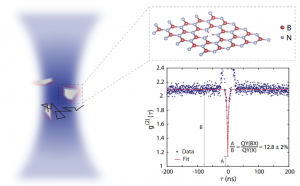by Aaron Lindenberg

A long-standing issue that limits the systematic improvement of single quantum emitters (SQEs) is the significant sample heterogeneity and consequent selection bias in choosing SQEs for characterization. To tackle this challenge, a spectroscopic method that can obtain sample-averaged performances with statistical significance is a prerequisite.
As part of the Q-NEXT Extreme Scale Characterization thrust and building on prior work on semiconductor nanocrystals, our team at Stanford University / SLAC developed solution-phase photon correlation spectroscopy to characterize the sample-averaged biexciton quantum yield in hexagonal boron nitride (hBN) SQEs, applicable at the single nanoflake level. This measurement of solution-phase SQE, shown in Fig. 1, yields a statistically averaged characterization of fundamental physical parameters without selection bias. Correlation analysis reveals submillisecond particle diffusion kinetics, microsecond emission via metastable states, submicrosecond nanoflake rotational dynamics, and nanosecond antibunching features due to high-purity quantum emission (shown in Fig. 1).
Our systematic analysis determines biexciton quantum yield in hBN SQEs, of key importance for the development of improved quantum emitters for entangled photon sources and laser applications. This method could greatly assist the synthetic effort to improve hBN SQEs by simplifying the previous single-emitter characterization method and can be directly translated to SQEs in other low-dimensional systems.
Building on this solution phase photon correlation spectroscopy, ongoing efforts are now focused on probing electron-phonon coupling in quantum emitters in an ultrafast single-molecule spectroscopic approach. At a microscopic level, electron-phonon coupling in SQEs fundamentally determines many of their key properties. Systematic mode-selective characterization of the strength and timescale of electron-phonon interactions in these systems, never before achieved, would significantly affect the functionality of these SQEs. Our efforts are now focused on capturing electron-phonon interactions in the time domain by developing advanced ultrafast single-molecule transient absorption spectroscopies.
Following the concept of solution-phase averaging, we are currently carrying out first measurements on solution-phase SQEs with pump-probe responses averaged over millions of SQEs diffusing through the laser focus to yield reliable quantitative characterizations. A double-pulse scheme while monitoring the second-order fluorescence correlation signal can record the transient absorption change as a function of pump-probe delay, directly reporting on the dynamical evolution of the stimulated emission transition in the single flake limit.
These table top measurements also set the stage for future atomic-scale sensitive dynamic probes of electron-phonon coupling in SQEs, building on X-ray and electron scattering beamlines at SLAC, to be carried out in the next year.
Aaron Lindenberg is a professor of materials science and engineering and of photon science at Stanford University.
This work was supported by the DOE Office of Science National Quantum Information Science Research Centers.
